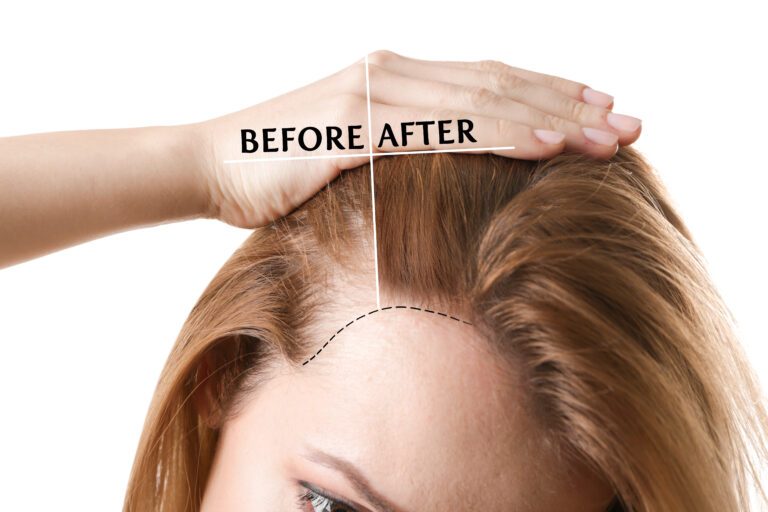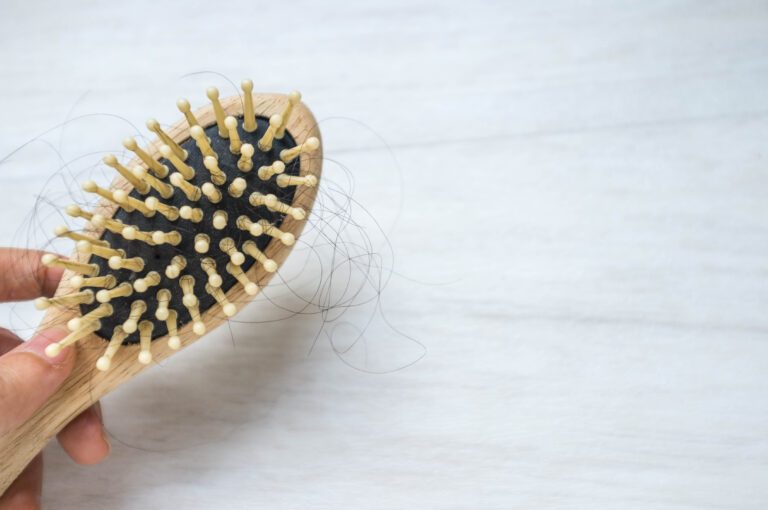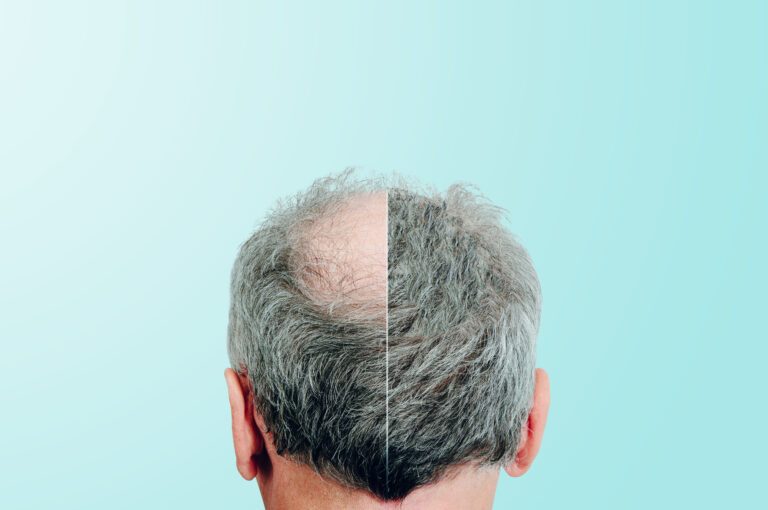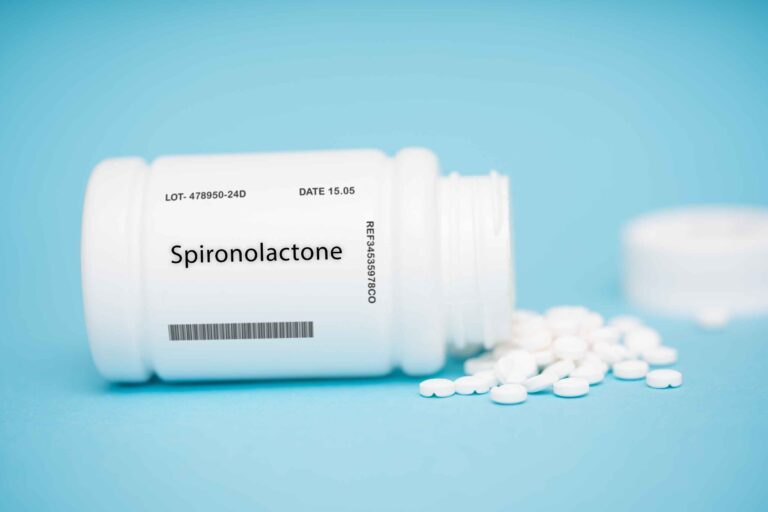Finasteride vs Dutasteride: Side Effects & Efficacy Compared for Hair Loss
Hair loss is a frustrating problem that affects millions of men and women all over the world, but luckily, there are also several treatments that can stop or even reverse the effects of hair loss.
Although there are many medications out there that are helpful for hair loss, the two most popular options that you might’ve heard of are Finasteride and Dutasteride.
Despite the apparent similarities between the two compounds, you might be curious as to which one of them is more effective and safer, and that’s exactly what this article is all about!
In today’s guide, we’ll put Finasteride vs Dutasteride in a brief head to head comparison, so you can understand the differences between them and make an educated decision about your hair loss treatment. So without further ado, let’s dive right in!
What Causes Hair Loss?
In order to understand how both treatments work, we should first take a look at the changes in your body that might cause hair loss in the first place.
Hormones play an essential role in the development of our bodies throughout our lives, especially when it comes to producing identifying sexual characteristics.
This includes the growth of genitals, maintaining muscle mass, change of voice depth, as well as facial hair, and other sex-defining features.
The DHT Hormone
Among the most important hormones that our bodies produce for that purpose are the androgens, including testosterone and dihydrotestosterone (DHT). Despite being dubbed as the “male sex hormones”, they’re also found in females with lesser concentration.
DHT is actually a byproduct of the testosterone hormone itself, which is when a small percentage of testosterone (around 10%) is converted to DHT with the help of an enzyme known as “5-α (5-alpha) reductase”.
From the earliest stages of pre-natal development all the way to adolescence, the concentration of the DHT hormone plays a critical role in the development of sexual characteristics.
However, as you grow into adulthood and full sexual maturity, excess DHT becomes less essential for your well-being and more of a burden on your body.
One of the major impacts that it has on the body is the advancement of male pattern baldness. The excess DHT in the bloodstream starts binding to certain hair follicle receptors in your scalp (depending on your genetic predisposition to male pattern baldness).
This causes the follicles to shrink, preventing them from creating healthy strands of hair, which translates to hair loss
What Is Finasteride?
Finasteride is one of the most popular prescription medications that are used to treat male pattern baldness.
The medication is also used to treat other conditions related to men’s health, such as benign prostatic hyperplasia or enlarged prostate as well as other unlisted indications that your doctor might suggest.
The treatment is available under a wide variety of brand names, including “Propecia”, “Proscar”, and simply “Finasteride”.
Finasteride is the only oral treatment that is approved by the Food and Drug Administration (FDA) for male pattern baldness, and it works by preventing the conversion of testosterone into DHT, the hormone responsible for thinning out hair follicles in the scalp.
History of Finasteride
The development of Finasteride started as early as the 1970s by Merck. By the late 1980s, the drug was already patented and pending clinical trials.
In 1992, the treatment was approved by the FDA and released into the market under the trade name “Proscar”.
During that time, the treatment was only approved for prostate enlargement or benign prostatic hyperplasia (BPH)
However, since DHT is responsible for both male pattern baldness and benign prostatic hyperplasia, balding patients started noticing the regrowth of their hair upon using the treatment.
By 1997, the FDA approved the use of Finasteride for the treatment of hair loss in men, although the dosage of hair loss treatment is smaller than that of the BPH.
Since that time, other generic finasteride medications under different brand names have been released into the market.
How Finasteride Works
As previously established, the DHT hormone is the one responsible for male pattern baldness in genetically predisposed patients.
Finasteride is an anti-androgen agent that works by blocking the enzyme 5-α reductase from doing its job (converting testosterone into DHT).
The chemical structure of finasteride allows it to bind to the enzyme instead of testosterone. This way, the hormone stays as it is instead of turning into DHT that affects hair follicles.
As a result, the concentration of DHT in the body is reduced, and so are its effects. After some time, the hair follicles start regaining their strength and regrow healthier and thicker hair strands.
What Is Dutasteride?
Dutasteride is a relatively newer drug that is officially developed to treat benign prostatic hyperplasia.
Although BPH is the only official indication for dutasteride, it has been commonly used and prescribed by doctors as an unlisted or informal treatment for male pattern baldness.
Like Finasteride, dutasteride is also sold under a variety of generic brands. However, the most popular one is “Avodart”, made by GlaxoSmithKline (GSK).
As the names suggest, Dutasteride and Finasteride are quite similar in many aspects, not just the name.
In fact, the two treatments have a lot in common when it comes to the mechanism of action, side effects, and more!
History of Dutasteride
Dutasteride is relatively new when compared to Finasteride. In fact, dutasteride was developed back in the late 1990s as a better alternative that is more effective than its older counterpart.
In 2001, the drug was released and gained FDA approval as a treatment for benign prostatic hyperplasia.
As of today, the treatment is yet to receive the FDA-approved status as a treatment for male pattern baldness and receding hairline, although many studies and clinical trials proved its effectiveness in that aspect.
In fact, the patent for dutasteride has expired recently (the patent for pharmaceuticals lasts for 20 years only), and many companies are already developing their generic brands of Dutasteride.
This means that pharmaceutical companies have very little incentive to get the treatment approved for hair loss.
This is why a lot of doctors believe that the FDA isn’t going to approve Dutasteride for hair loss any time soon, although that didn’t stop many of them from prescribing the treatment for that purpose.
How Dutasteride Works
Dutasteride is also a 5-α reductase enzyme inhibitor. This means that it has almost the same mechanism of action as Finasteride.
With that being said, you should know that there are two different types of 5-α reductase enzymes in the body, known as type I and type II.
Dutasteride is designed so that it targets both types of 5-α reductase enzyme while Finasteride targets type I only.
In other words, dutasteride actually blocks the reductase enzymatic action at a higher rate than Finasteride, which is one of the main highlights of the treatment.
What Are the Side Effects of Finasteride and Dutasteride?
Both finasteride and dutasteride are quite effective when it comes to the treatment of male pattern baldness, and we’ll discuss the effectiveness of the drug in further detail in the following sections.
With that being said, Finasteride and Dutasteride come with a variety of side effects that vary in terms of frequency and severity depending on individual differences.
Since the two treatments belong to the same pharmaceutical family and have similar mechanisms of action, it’s no surprise that both of them have the same array of side effects.
These are classified into common side effects, sexual side effects, as well as allergic reactions, and more serious ones.
Common Side Effects
These side effects are quite common, but luckily, they’re the least concerning ones. These effects include:
- Dizziness and weakness
- Headaches and migraines
- Bloating
Sexual Side Effects
The most widely-discussed side effects of Dutasteride and Finasteride are related to the disturbance of hormonal balance in the body.
This is because blocking 5-α reductase may inhibit its action but the concentration of the DHT hormone remains high in the bloodstream.
Reduced Libido
Another side effect of using these medications is reduced interest in sexual activity. This one is the most commonly reported sexual side effect among Finasteride users.
According to a study published in the Journal of Sexual Medicine, 94% of patients who displayed sexual side effects reported reduced libido and 92% reported decreased arousal.
Erectile Dysfunction and Persistent Erectile Dysfunction
Erectile dysfunction is a condition in which men have problems establishing or maintaining an erection.
A 2014 study on the side effects of 5-α reductase inhibitors found a significant increase in the sexual side effects of the treatment, especially erectile dysfunction when compared to those who received a placebo treatment.
These findings were also confirmed by another study, which found that 167 patients out of 11,909 (1.4%) who took Finasteride or Dutasteride for male pattern baldness reported persistent erectile dysfunction that lasted for several months or even years after stopping the treatment.
Ejaculatory Disorders
Both finasteride and Dutasteride were associated with various ejaculatory disorders, including premature ejaculations and delayed ejaculations.
According to a systematic review of various studies, patients who used Finasteride and Dutasteride reported a significant increase in ejaculatory problems compared to patients who received a placebo.
Impotence and Reduced Fertility
Although impotence isn’t as common as other sexual side effects, it’s still reported among patients who use the treatment for male pattern baldness as well as enlarged prostates.
According to a study on male fertility upon using Finasteride, it was found that 26 out of 4,400 (0.6%) men using the drug had a notable reduction in sperm count after taking the medicine for an average of 57.4 months.
Testicular Pain or Discomfort
Another rare side effect that is reported after the cessation of Finasteride and Dutasteride is testicular discomfort, which is also described as mild pain in testicles with or without a reduction in their size.
These symptoms are so rare that they’re only mentioned in a few reports, including a recent 2020 study of “post-finasteride syndrome”.
Psychological Side Effects
Disturbance of hormones can also cause fluctuations in mood as well as other psychological disorders, such as depression.
A study published in late 2021 reported a noticeable increase in cases of depression among 5-α reductase inhibitor users.
According to the study, this is caused due to changes in neuroactive steroids that affect the balance of the dopaminergic system.
Some people also claim that Finasteride and Dutasteride also increase suicidal thoughts. However, studies showed that these drugs only cause depression without an increased risk of suicide.
Serious Side Effects
Luckily, the most serious side effects of Dutasteride and Finasteride are also the rarest. These side effects include:
Gynecomastia
Gynecomastia is the increased size of breasts among men. This is also associated with the hormonal imbalance caused by 5-α reductase inhibitors and increased DHT hormone levels in the bloodstream.
The condition is also more common among benign prostatic hyperplasia, so it’s less common among low-dose usage associated with male pattern baldness, according to a 2019 study.
Tenderness, discomfort, and slight pain in the breast are also common, with or without gynecomastia.
Additionally, some patients also reported symptoms of Male Mammary Maladies, which include finding lumps and discharge from the nipples.
Cancer
5-α reductase inhibitors are associated with the overall reduction or management of prostate cancer.
However, despite being extremely rare, some studies still link the use of the drugs with elevated levels of prostate cancer susceptibility as well as breast cancer in men.
Allergic Reactions
Lastly, allergic reactions can be a problem among 5-α reductase inhibitors if your body is sensitive to the main ingredient of these drugs or any other exceptions and inactive ingredients used in the formulation of the drug.
These symptoms include anything from a mild rash to hives, heavy itching, and swelling of the face and lips.
If you feel any of these side effects after starting Finasteride or Dutasteride, you should contact your doctor immediately and seek emergency medical care.
Depending on the severity of the effects, your doctor might replace the treatment or stop it altogether.
How Do Finasteride and Dutasteride Compare to Each Other?
Now that you know more about Finasteride and Dutasteride, you might be curious about the differences and similarities between them.
In the following section, we’ll take a closer look at those aspects, so you can have a better understanding while choosing a suitable one for your needs:
The intensity of the Effect
As you now know, Finasteride and Dutasteride both have the same mechanism of action. However, their intensities are not exactly the same.
Since Dutasteride targets both type I and type II 5-α reductase enzymes, it has a more intense effect on the DHT levels.
These findings were confirmed by a study that measures the intensity of DHT hormone suppression upon using the two drugs.
According to this study, 0.5 mg of Dutasteride was capable of inhibiting more than 90% of 5-α reductase enzymes while 1.0 mg of Finasteride managed to inhibit up to 70% only.
Data Availability and FDA Approval
As we’ve discussed earlier, Finasteride is several decades older than Dutasteride. This means that Finasteride has been tested by a much larger population than its counterpart.
As a result, there is more data and clinical trials that fully study Finasteride’s effectiveness as well as potential side effects than Dutasteride.
However, this was mainly a concern back in the early 2000s when Dutasteride was still new to the market and not many comparative analyses were performed using the two drugs.
Another related aspect here is the FDA approval. Between Dutasteride and Finasteride, the latter is the only one that is approved by the FDA for the treatment of hair loss and male pattern baldness.
Of course, granting the FDA approval didn’t stop doctors from prescribing Dutasteride because it proved to be quite effective when it comes to hair loss.
However, a lot of people are still hesitant about using a drug that isn’t approved by one of the largest governing bodies of medications around the world.
With that being said, you should know that other countries around the world, especially Asian countries, actually approved Dutasteride for the treatment of alopecia and male pattern baldness too.
This includes South Korea in 2009 and Japan in 2015. In fact, in these countries, Dutasteride is more prescribed than Finasteride for the treatment of hair loss!
Medical Insurance
Your choice between Finasteride and Dutasteride might also vary depending on the policies of the medical insurer you are subscribed to.
Although both drugs are commonly available in pharmacies, the insurance company prefers one treatment over the other, so you’re technically stuck with one choice.
Since the FDA only approves Finasteride, issuing Dutasteride prescriptions might come with a little more legal hassles.
Dosage Form
Finasteride is offered in the form of oral tablets. Finasteride is usually available in two different dosages, which are 1 mg and 5 mg taken once daily.
The lower dose is mainly for hair loss and male pattern baldness while the higher one is more commonly used in benign prostatic hyperplasia.
On the other hand, Dutasteride is a more potent 5-α reductase inhibitor, so it’s usually available in smaller doses of 0.5 mg taken once daily in the form of capsules.
Both treatments require continuous daily use for about 3 months before you can see any noticeable results.
They are used for a long time, and in some situations, patients will need to use them for the rest of their lives. However, if you stopped taking them after continuous use, the reversal effect might take up to 12 more months.
Drug Interactions
Drug Interaction is another aspect where the two treatments differ. Despite being very close chemically, Finasteride doesn’t have common drug interactions while Dutasteride is reported to interact negatively with various drugs, such as
- Some high blood pressure drugs like amlodipine (Norvasc)
- Some antibiotics like azithromycin (Zithromax and Azasite)
- Some antiviral drugs like ritonavir (Norvir)
Keep in mind that other medications might still interact with either Finasteride or Dutasteride, so make sure that you consult your pharmacist or physician before using these medications if you’re under any kind of treatment.
Average Price
If you’re going to use Finasteride or Dutasteride, you’ll need to continue using them for a very long time, so the costs of these treatments may add up if you’re not insured.
Although the prices may vary depending on where you live, the average retail price of Finasteride is usually around 55% more affordable than Dutasteride per tablet.
Which One Is More Effective for Hair Loss?
Since Dutasteride is more potent than Finasteride, it’s no surprise that it’s actually the more effective treatment when it comes to hair loss.
Although it’s difficult to estimate exactly how much more effective Dutasteride is, several attempts and studies were conducted.
According to one study that compared 1 mg of Finasteride to 0.5 mg of Dutasteride, the latter showed obvious superiority when it comes to new hair growth (31 to 4 new hair strands in 24 weeks).
Another study also found various rates of hair growth among different groups under various placebo, Finasteride, and Dutasteride treatments. The findings of each dosage were:
- Placebo: lost 32.3 hairs
- Finasteride (5 mg) – a high dose mainly used for BPH): gained 75.6 hairs
- Dutasteride (0.1 mg): gained 78.5 hairs
- Dutasteride (0.5 mg) – the most common daily dose): gained 94.6 hairs
- Dutasteride (2.5 mg): gained 109.6 hairs
Additionally, a 2019 systematic review and meta analysis of various other studies concluded that Dutasteride has consistently shown a higher level of efficacy compared to Finasteride across the majority of trials.
Which One Has Less Serious Side Effects?
Although both treatments show similar side effects, most scientific evidence and literature published found that Finasteride has less serious side effects than Dutasteride, especially when it comes to sexual side effects and dysfunctions.
For example, a study that compares the sexual side effects of 0.5 mg of Dutasteride and 5 mg of Finasteride found a marginal difference between the two (11% to 14% respectively), keeping in mind that 5 mg of Finasteride is a relatively high dose.
Another study on the adverse effects of Finasteride and Dutasteride also found the two treatments to be very well-tolerated and have fairly marginal differences in terms of side effects.
Moreover, a review of other studies between 1990 and 2018 found that Dutasteride shows similar rates of adverse sexual effects while being more effective.
However, like all other medications that affect hormonal balance, you have to be extremely careful while using these treatments and follow the dosage prescribed by your doctor while using either of the drugs.
We also recommend that you don’t think much about the side effects of those treatments because many patients actually suffer from a Nocebo effect, in which patients who expect negative side effects are more likely to suffer from them.
Which One Should You Go for?
Both Finasteride and Dutasteride are very tolerable and suitable treatments when it comes to hair loss.
Of course, choosing one over the other is usually best left to a physician that is more familiar with your medical history.
However, most dermatologists will recommend starting out with a daily dose of 0.5 mg Finasteride as a first-line treatment.
If the treatment shows little progress, the doctor might recommend switching to the more potent Dutasteride.
Who Shouldn’t Take Finasteride or Dutasteride?
Both Finasteride and Dutasteride are prescribed to men (18 years or older) who suffer from receding hairline and other forms of male pattern baldness unless the patient is allergic to any ingredients of the medication.
Since the treatments disturb the balance of androgens in the body, the treatment is not recommended for women or children.
In fact, pregnant women shouldn’t even handle crushed tablets because they can be absorbed by the skin and cause serious birth defects and deformities in male babies, especially the genitals.
Alternatives to Finasteride and Dutasteride
Although both Finasteride and Dutasteride are highly effective when it comes to treating hair loss, many pharmaceuticals looked for safer alternatives that might have less severe side effects.
The most popular – and possibly the safest – alternative is Minoxidil. This medication was originally intended for the treatment of high pressure but it was also found effective in controlling and reversing hair loss.
The most popular brand name of Minoxidil in Rogaine, which is used in topical form and applied directly to the scalp. Other alternatives also include:
- Tamsulosin
- Doxazosin
- Silodosin
Wrap Up
There you have it! A brief guide that walks you through everything you need to know about Finasteride and Dutasteride, so you can choose the one that works best for you!
Although both drugs’ properties are pretty similar in various aspects, they still have some key differences that set them apart.
Finasteride is older and is already approved by the FDA for hair loss. Alternatively, Dutasteride is remarkably effective but still used off-label because it’s currently only approved for benign prostatic hyperplasia.
Before making a decision, make sure that you consult your doctor or pharmacist about the two treatments. Since they’re quite familiar with your medical history, they can help you make the right decision for your health!







